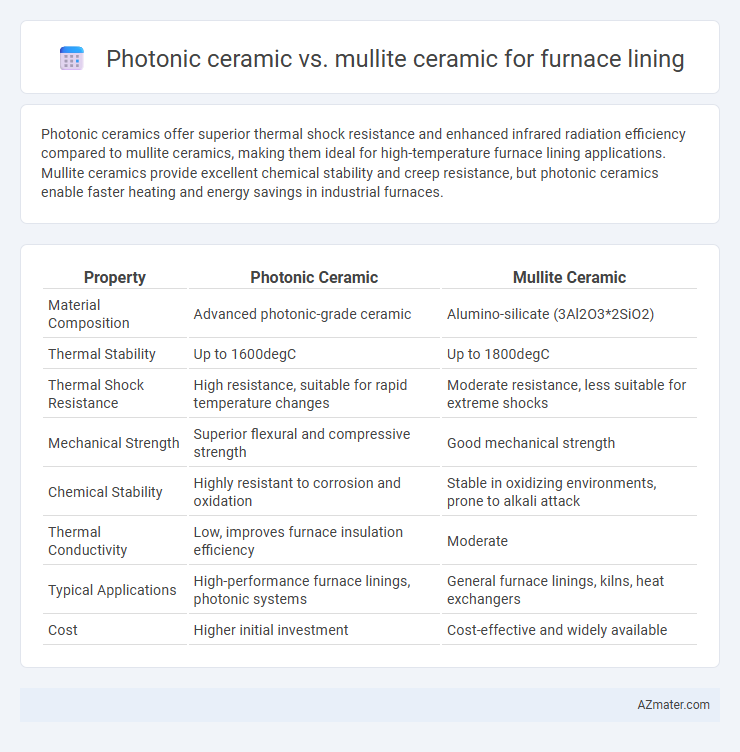Photonic ceramics offer superior thermal shock resistance and enhanced infrared radiation efficiency compared to mullite ceramics, making them ideal for high-temperature furnace lining applications. Mullite ceramics provide excellent chemical stability and creep resistance, but photonic ceramics enable faster heating and energy savings in industrial furnaces.
Table of Comparison
| Property | Photonic Ceramic | Mullite Ceramic |
|---|---|---|
| Material Composition | Advanced photonic-grade ceramic | Alumino-silicate (3Al2O3*2SiO2) |
| Thermal Stability | Up to 1600degC | Up to 1800degC |
| Thermal Shock Resistance | High resistance, suitable for rapid temperature changes | Moderate resistance, less suitable for extreme shocks |
| Mechanical Strength | Superior flexural and compressive strength | Good mechanical strength |
| Chemical Stability | Highly resistant to corrosion and oxidation | Stable in oxidizing environments, prone to alkali attack |
| Thermal Conductivity | Low, improves furnace insulation efficiency | Moderate |
| Typical Applications | High-performance furnace linings, photonic systems | General furnace linings, kilns, heat exchangers |
| Cost | Higher initial investment | Cost-effective and widely available |
Introduction to Furnace Lining Materials
Furnace lining materials like photonic ceramics and mullite ceramics play a critical role in thermal insulation and structural integrity under high temperatures. Photonic ceramics offer superior thermal shock resistance and enhanced emissivity, optimizing heat distribution, while mullite ceramics provide excellent mechanical strength and stability at elevated temperatures due to their high alumina-silica content. Selection between these materials depends on operational temperature, thermal cycling demands, and desired energy efficiency in industrial furnaces.
Overview of Photonic Ceramic
Photonic ceramic exhibits superior thermal stability and enhanced infrared emissivity, making it ideal for furnace lining applications requiring efficient heat management. Its microstructure allows for excellent resistance to thermal shock and oxidation, outperforming traditional mullite ceramics in high-temperature environments. Photonic ceramic's tailored optical properties contribute to energy savings by improving heat retention and reducing energy consumption within industrial furnaces.
Overview of Mullite Ceramic
Mullite ceramic, known for its exceptional thermal stability and low thermal expansion, is a preferred material for furnace lining in high-temperature applications. Its ability to withstand temperatures up to 1700degC without deformation makes it ideal for harsh furnace environments. Mullite's excellent resistance to thermal shock and chemical corrosion enhances furnace efficiency and longevity compared to photonic ceramics.
Thermal Insulation Properties Comparison
Photonic ceramics exhibit superior thermal insulation properties compared to mullite ceramics, featuring lower thermal conductivity values typically around 0.2-0.4 W/m*K, which enhances energy efficiency in furnace lining applications. Mullite ceramics, with thermal conductivity ranging from 2-5 W/m*K, provide good thermal shock resistance but generally allow more heat transfer than photonic ceramics. The advanced microstructure of photonic ceramics reduces heat loss and improves furnace temperature stability, making them preferable for high-performance insulation in industrial furnaces.
Mechanical Strength and Durability
Photonic ceramic exhibits superior mechanical strength and thermal shock resistance compared to mullite ceramic, making it highly suitable for furnace lining applications subjected to extreme temperature fluctuations. Mullite ceramic, while offering good oxidation resistance and thermal stability, generally has lower strength and durability under mechanical stress than photonic ceramic. The enhanced mechanical robustness and longer service life of photonic ceramics reduce maintenance frequency and improve overall furnace efficiency.
Chemical Resistance in High-Temperature Environments
Photonic ceramics exhibit superior chemical resistance compared to mullite ceramics in high-temperature furnace linings due to their stable photonic crystal structure, which minimizes corrosion from molten slags and aggressive gases. Mullite ceramics, while offering good thermal stability and moderate chemical resistance, are prone to gradual degradation in highly reactive environments, especially at temperatures exceeding 1500degC. The enhanced durability of photonic ceramics under oxidative and reducing atmospheres makes them more suitable for prolonged use in industrial furnaces exposed to harsh chemical conditions.
Energy Efficiency and Heat Loss Reduction
Photonic ceramic furnace linings exhibit superior energy efficiency due to their enhanced thermal insulation and low thermal conductivity, minimizing heat loss during high-temperature operations. Mullite ceramic, while providing excellent thermal shock resistance and mechanical strength, typically has higher thermal conductivity, resulting in comparatively greater heat loss. Optimizing furnace efficiency favors photonic ceramics for reducing energy consumption and maintaining stable internal temperatures.
Lifespan and Maintenance Requirements
Photonic ceramic offers superior thermal shock resistance and longer lifespan compared to Mullite ceramic, which tends to degrade faster under high-temperature cycling in furnace linings. Maintenance requirements for photonic ceramics are lower due to their enhanced durability and resistance to chemical corrosion, reducing downtime and repair frequency. Mullite ceramics often require more frequent inspections and replacements to maintain optimal furnace performance.
Cost Analysis and Economic Considerations
Photonic ceramic offers superior thermal insulation and durability compared to mullite ceramic, resulting in lower energy consumption and reduced maintenance costs in furnace lining applications. Mullite ceramic, while generally less expensive upfront, tends to have a shorter lifespan and higher replacement frequency, increasing long-term operational expenses. An economic analysis shows that investing in photonic ceramic can lead to substantial cost savings over the furnace lifecycle despite its higher initial price.
Choosing the Right Ceramic for Optimal Furnace Performance
Photonic ceramics exhibit superior thermal shock resistance and high emissivity, making them ideal for efficient heat radiation in furnace linings. Mullite ceramics offer exceptional mechanical strength and thermal stability at high temperatures, ensuring durability under continuous furnace operation. Selecting the right ceramic depends on balancing the thermal insulation properties of photonic ceramics with the structural resilience of mullite to achieve optimal furnace performance.

Infographic: Photonic ceramic vs Mullite ceramic for Furnace lining
 azmater.com
azmater.com